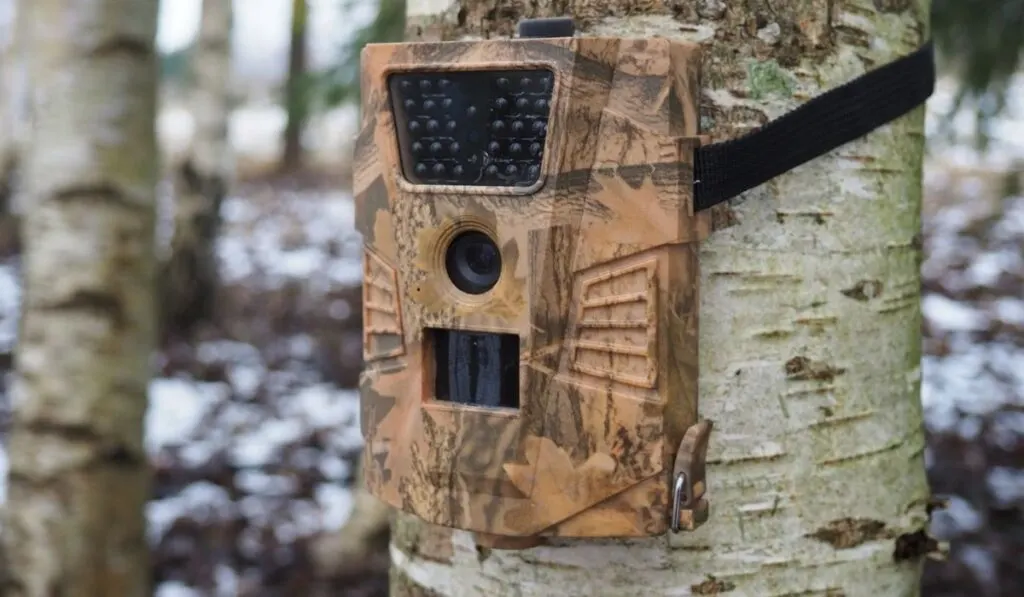Game cameras are used to track, detect, and monitor wildlife. Many of these cameras have features that make for excellent home security systems.
You can use game cameras for home security. Game cameras are suited for stealth and outdoor use. These cameras come with features such as live feeds, video, and an extended motion detection range. All of these features make game cameras an excellent home security option.
Although trail cameras are robust and feature-packed, there are some factors to consider. Read on for everything you need to know on game cameras for home security.
How Game Cameras Work

Game cameras, or trail cameras, are typically mounted to a tree. The game camera’s motion sensors will turn on when wildlife enters the area. The camera will snap photos or videos of the moving animal. Most cameras have timestamps, so you know when the animal passed by. Additionally, many game cameras are capable of sending videos and pictures to your smartphone in real-time.
Using Game Cameras for Home Security
Although these cameras may not be everyone’s first option, trail cameras can be excellent home security devices. These cameras are designed for stealth and outdoor use, making them hard to spot and durable. Additionally, these cameras come with plenty of features that benefit hunters and homeowners alike.
Features to Consider
Game cameras come with a wide variety of features. Whether it’s video and audio detection or wireless capabilities, there is sure to be an option that suits your needs and budget.
Motion Sensor & Detection Range
The motion sensor and detection range may be the most important factors when choosing a quality security camera. A larger property will need a camera with a broader range.
Additionally, you should always test the motion sensor before purchasing. A faulty motion sensor will render your trail camera useless. Most cameras will have both thermal and infrared sensors.
Picture Quality
Capturing and detecting motion are only the first parts of a security camera. Picture and video quality should be factored in just as much. Without quality visuals, you won’t be able to translate the information.
Wireless trail cameras tend to produce better pictures than CCTV cameras. CCTV cameras are commonly grainy and hard to read. So, look for cameras with a minimum 8-megapixel quality for the best results.
Video & Audio Features
Some trail cameras only come with photo capabilities. If you need video detection, be sure to find a camera that suits your needs. Additionally, you can find cameras that support audio feedback. Audio feedback can give you a better idea of what a trespasser is planning.
No-Glow Features
Be sure to purchase a game camera with no-glow and no-flashback features. These features ensure your camera is using infrared detection. Infrared detection means your camera won’t alert any thieves with flashes or glowing lights. Additionally, this feature provides your camera with nighttime surveillance capabilities.
Cellular Capability
As mentioned earlier, many trail cameras are compatible with cell phones. These cameras can send photos, videos, and updates directly to your phone. If your concern is monitoring your property while you’re away, this feature is a must.
Battery Life
Be sure to find trail cameras with long battery life. The last thing you want is for your security system to die on you in the middle of the night. Battery life can also be an indicator of connection strength, meaning the longer the battery lifespan, the stronger the camera.
Timestamps
Timestamps are crucial for security purposes. More information is better when tracking down thieves and intruders. Fortunately, most trail cameras come with timestamps. Be sure to turn on these features during the initial setup phase.
Safety Features
Some intruders and thieves will steal your camera outright. Fortunately, many trail cameras come with locks and safety features. If you’re concerned about your camera’s safety, opt for products with password protection and lock-out mechanisms.
How to Hide Game Cameras for Security

Deer and wildlife aren’t likely to notice a trail camera. Unfortunately, thieves and criminals tend to be a bit sharper. Properly hiding and placing your trail camera is crucial to its performance.
Place at an Angle
Be sure to place your security cameras at an angle. Doing so ensures your cameras are less likely to be spotted by intruders. Some good areas to consider are the roof, near rain gutters, atop poles, atop trees, or any other location that isn’t obvious.
Security trail cameras should be placed at an angle so they cannot be easily seen by intruders. Examples are the roof, near the gutters, a pole or post, or any other location that would not be in the direct line of sight of a person.
Place Away From Direct Light
Avoid placing your security cameras in front of direct light. Direct sources of light can cause lens flare, rendering your cameras useless. Try putting them away from direct sources of light or in shaded areas.
Use Proper Distance
Always factor in your security camera’s detection range when choosing a placement. Doing so ensures you’re getting the most coverage out of your camera. Read all of the instructions, guidelines, and specifications on your camera for the best results.
